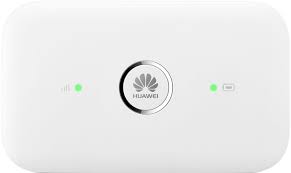
Mobile devices that attach to the network

Samsung S8 Plus - their current top of the range phone
image ©samsung.co.uk
Typical devive that provides mobile Internet
image ©huawei.co.ukTalk of the mobile phone network and the obvious device that can connect to the network is a mobile phone. But these are not the only devices that can connect to the network. At the user end of the mobile phone network is the equipment used by the user to connect to the wireless part of the network. Often called the mobile client or, in technical documents the Mobile Station (MS).
- Mobile Phone - The initial purpose of MPT was to provide a mechanism for mobile telephony. The simplest mobile phones are able to provide phone and text services with most able to provide much more.
- Smart Phones - A Smart Phone is much more than a phone, it is often called the computer in your pocket which can send and receive data. This data interface allows these small computers to carry out a variety of applications, from navigation to office facilities, from fitness recording to playing games, and much of social media is driven by these devices. There are two families of these phones (1)The Apple iPhone and (2)Android phones provided by manufacturers such as Samsung, Huawei, and Google. It can be argued that these smart phones are driving change in modern society.
- Tablets - whilst many tablets work on WiFi, some of these devices have a SIM slot allowing connection to the Internet. This makes these tablets much more portable. They can connect to the Internet wherever there is a mobile network connection.
- Battery Powered Mobile Router A small battery powered, pocket sized device providing a WiFi signal, which uses a mobile connection to provide the Internet. Thus they allow working on a laptop anywhere there is a mobile network. So when working in a coffee shop, a customer can use their own dongle that is more secure than the common WiFi available at these establishments.
- Mobile Routers - a home router is needed to connect to home broadband. Most often these rely on a fibre or copper connection to establish the Internet. A mobile router uses a SIM to connect to the Internet through 4G/5G, rather than relying on a wired connection. With the ability to connect up to 64 devices, these routers can be the core of any portable office or indeed provide mobile broadband as an alternative to fixed broadband in the home.
- Smart Meters The UKG is promoting the use of a smart meter in the home. These meters need a wireless connection back to the energy company. This is currently achieved in over half the UK via a 2G connection. Soon this will be upgraded to 4G over the whole of the UK.
- IoT Devices A mobile [moving] IoT device needs to connect to the backend server via a wireless connection provided by the mobile network. Many vehicle tracking devices will use such technology. Additionally IoT devices in remote places, such as in the countryside also use the available mibile network to provide the backhaul.
The mobile phone network has to be able to cater for each of these different types of mobile stations. These devices have different characteristics. In particular the requirements of any IoT device is much different to a smart phone streaming a movie.
© mobilephonetechnology.co.uk all rights reserved 2017-2025
